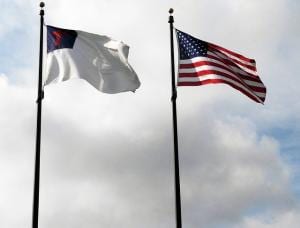 Earlier this week, out of idle curiosity I picked up Katherine Stewart’s new book The Power Worshippers: Inside the Dangerous Rise of Religious Nationalism. Stewart—the author of a somewhat notorious recent New York Times op-ed seemingly blaming American evangelicals for the spread of coronavirus—has penned a volume that will greatly appeal to a particular sort of person.
Earlier this week, out of idle curiosity I picked up Katherine Stewart’s new book The Power Worshippers: Inside the Dangerous Rise of Religious Nationalism. Stewart—the author of a somewhat notorious recent New York Times op-ed seemingly blaming American evangelicals for the spread of coronavirus—has penned a volume that will greatly appeal to a particular sort of person.
To wit, The Power Worshippers favorably compares itself to Jane Mayer’s Dark Money and Nancy MacLean’s Democracy In Chains. That’s perhaps an odd choice, given that both of those books have been roundly challenged on grounds of reductionism and historical inaccuracy. But no matter: Stewart’s book is, self-consciously, the latest major installment in the ongoing project of conspiratorial fan-fiction that one might call “The Secret History of the American Right.” And viewed through that lens, when I ask myself whether the book succeeds at its primary task—scandalizing MSNBC devotees—I must admit it probably does.
The Power Worshippers is exactly what you would expect from that sort of book. It’s a freewheeling tour through almost everything loosely connected to American Protestantism that Stewart finds distasteful—conservative political organizing, support for the oil and gas industries, the “ex-gay” movement, the March for Life, the Museum of the Bible, the school choice movement, the Federalist Society, and so on. There is nothing in here that casual readers of the Huffington Post don’t already know about.
If I sound dismissive, it’s because I am. Though I don’t know that I’d self-identify as evangelical—conservative Lutherans occupy a curious place in the tradition—I’m well acquainted with almost every phenomenon Stewart writes about, and I personally know a good many of the “central players” in her book. Speaking as someone who’s experientially pretty well qualified to judge whether The Power Worshippers is an interesting or incisive look at American social conservatism, I can quite confidently say that it is not.
At bottom, The Power Worshippers is a bad book because it’s telling the wrong story. Maybe this book could’ve plausibly been written during the Bush years—back when Damon Linker was commenting on “the theocons”—but the landscape has changed dramatically since then.
Specifically, the most interesting development in American conservatism over the last 5-10 years is the slow crackup of fusionism—the Reagan-area alliance between a libertarian-minded business class and socially conservative suburbanites and middle-class voters. In part, this splintering is rooted in an ascendance of ostensibly “right-wing” political leaders alongside a sustained failure to advance social-conservative policy goals, a failure perhaps rooted in the culturally leftward drift of large corporations and their leadership. Today’s business leaders regularly champion abortion rights and LGBT rights in ways that might’ve seemed unthinkable a decade or two previously—and in so doing, have introduced a rift into the GOP coalition. As it were, that’s the broader background tension that gave rise to Harvard law professor Adrian Vermeule’s controversial article earlier this week arguing for a “common-good constitutionalism” that would abandon methodological originalism altogether. In responding to Vermeule, Georgetown law professor (and libertarian) Randy Barnett correctly noted “a disturbance in the originalist force by a few, mostly younger, socially conservative scholars and activists . . . disappointed in the results they are getting from a ‘conservative’ judiciary.”
But there’s also a second cleavage at work here too, one far older. Critically, Vermeule’s project rests on the rejection of the very Catholic/Protestant consensus that propelled the Reaganite “theocons” to power in the first place. Where a prior generation of Catholics and Protestants once joined hands to defend an ideal liberal democracy against atheistic Soviet communism, Vermeule (and those who share his critique of liberalism writ large) see only a tragically flawed rapprochement between servants of the common good and degenerate individualists. Yet if, as Stewart implies, the Christian right is a monolithic bloc within a few steps of securing total political domination, the old Protestant/Catholic alliance must remain intact.
In the real world, American social conservatism has found itself at a bit of an impasse. In one corner (admittedly, a rather small corner) are Catholics—like Vermeule—who would forcibly coerce Protestants to attend Mass, and in another are those rural evangelicals, some of which Stewart describes, who wouldn’t even acknowledge Catholics as fellow Christians. It strikes me as flatly inconceivable that these factions are really capable of collaborating to impose the unified theocratic control that Stewart threatens. And that, of course, raises an interesting question all its own: might the religious pluralism of America’s earliest days, in which colonists of divergent creeds founded diverse states, have actually immunized it against the kind of totalizing religious control Stewart deplores? (Is it possible that “Catholic America” or “Baptist America” is a contradiction in terms?)
Stewart, unfortunately, has no interest in telling any of these stories. Indeed, it’s possible she’s not even aware of them. To name one example, readers are introduced to R.J. Rushdoony—ardent proponent of a Calvinist “theonomy” that would impose Levitical law in the modern era, and critic of American liberalism on grounds similar to Vermeule’s—but he’s invoked once as a boogeyman and never again discussed, despite the fact that his writings foreshadowed contemporary internecine debates. Readers interested in a serious look at the development of American conservatism over time must turn elsewhere; Ken Kersch’s Conservatives and the Constitution: Imagining Constitutional Restoration in the Heyday of American Liberalism might be a solid alternative.
As it were, the most thought-provoking aspect of The Power Worshippers is, almost certainly, an unintentional one. Authors like Stewart strike me as willing to tolerate—if not ever align with—conservative religious people of a particular stripe. Notwithstanding Linker and his “theocon” paradigm, almost no one seriously lumps Benedict XVI (or, for that matter, Tim Keller) in with Jerry Falwell, Breitbart, or prosperity-gospel megachurches, despite the pope emeritus’s very conservative views on abortion and sexuality and sharp criticisms of Western culture. Rather, this kind of author reserves a particularly virulent contempt for evangelicals (and to the extent a denomination is singled out, Southern Baptists). Not to put too fine a point on it, but I’m certain that if I mentioned at a New Haven cocktail party that I was a member of the “Lutheran Church—Missouri Synod,” I’d get polite nods and maybe one or two murmurs of “I was baptized Episcopalian myself.” But if I said I was an evangelical, guests would stiffen and a subtle but perceptible chill would set in.
Obviously, more is going on here than simple ideological opposition. That’s because, in a lot of circles, evangelical is a class marker as much as a religious one. It telegraphs backwardness, unsophistication, and all the aesthetic unpleasantness the privileged seek to avoid. And so, it seems to me, there’s almost always a thinly veiled classism at work in books and articles like this one: Lord, thank you that I am not like those poor, ignorant rubes. That is not an especially becoming look for anyone who claims to prioritize “democratic values.”
There’s a lot more I could comment on in The Power Worshippers, in particular Stewart’s repeated insistence that America’s Founders sought to establish a strictly secular republic—here, it seems worth noting that Stewart’s husband, a scholar of Baruch Spinoza’s work, has advanced his own, rather tendentious historical account of the Founding—but I don’t really see the point. This is not a work of serious history or incisive investigative journalism, and it makes no sense to hold it to that standard. No one on either side of the aisle will have their opinions swayed by Stewart’s claims, and curious centrists should have the intellectual wherewithal to pick up something more rigorous.
There is certainly a fascinating and compelling study to be written about the uneasy alliances on the political right as of 2020. But this is not the one.












